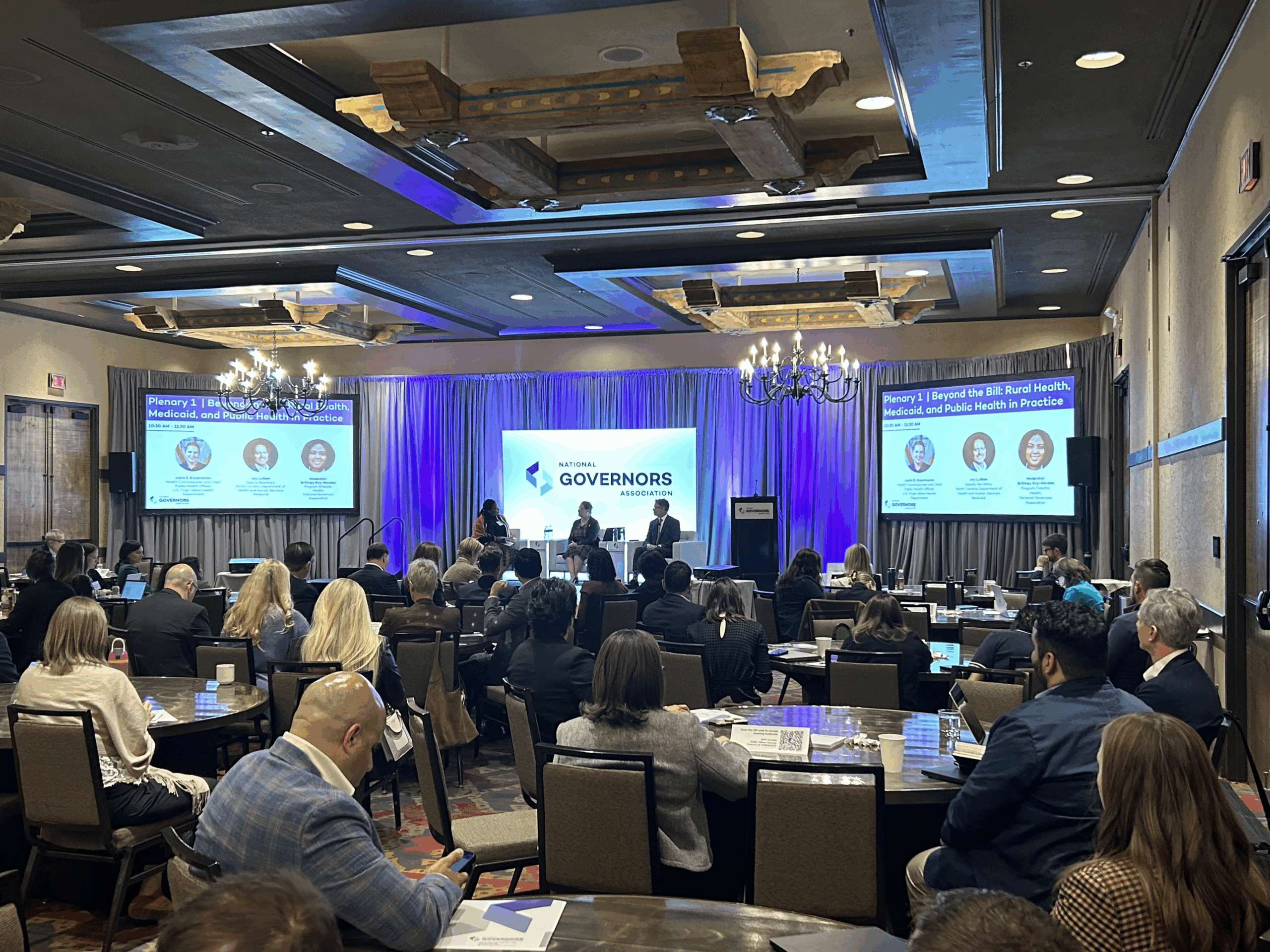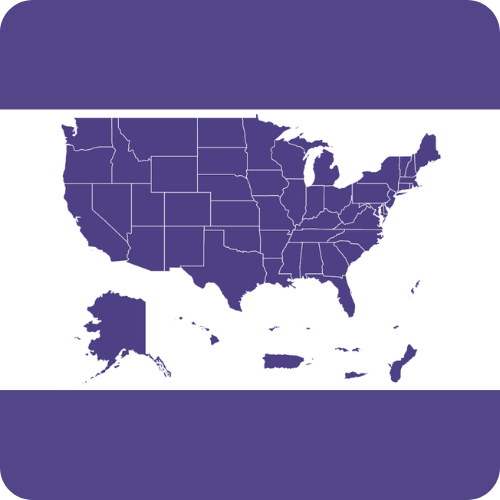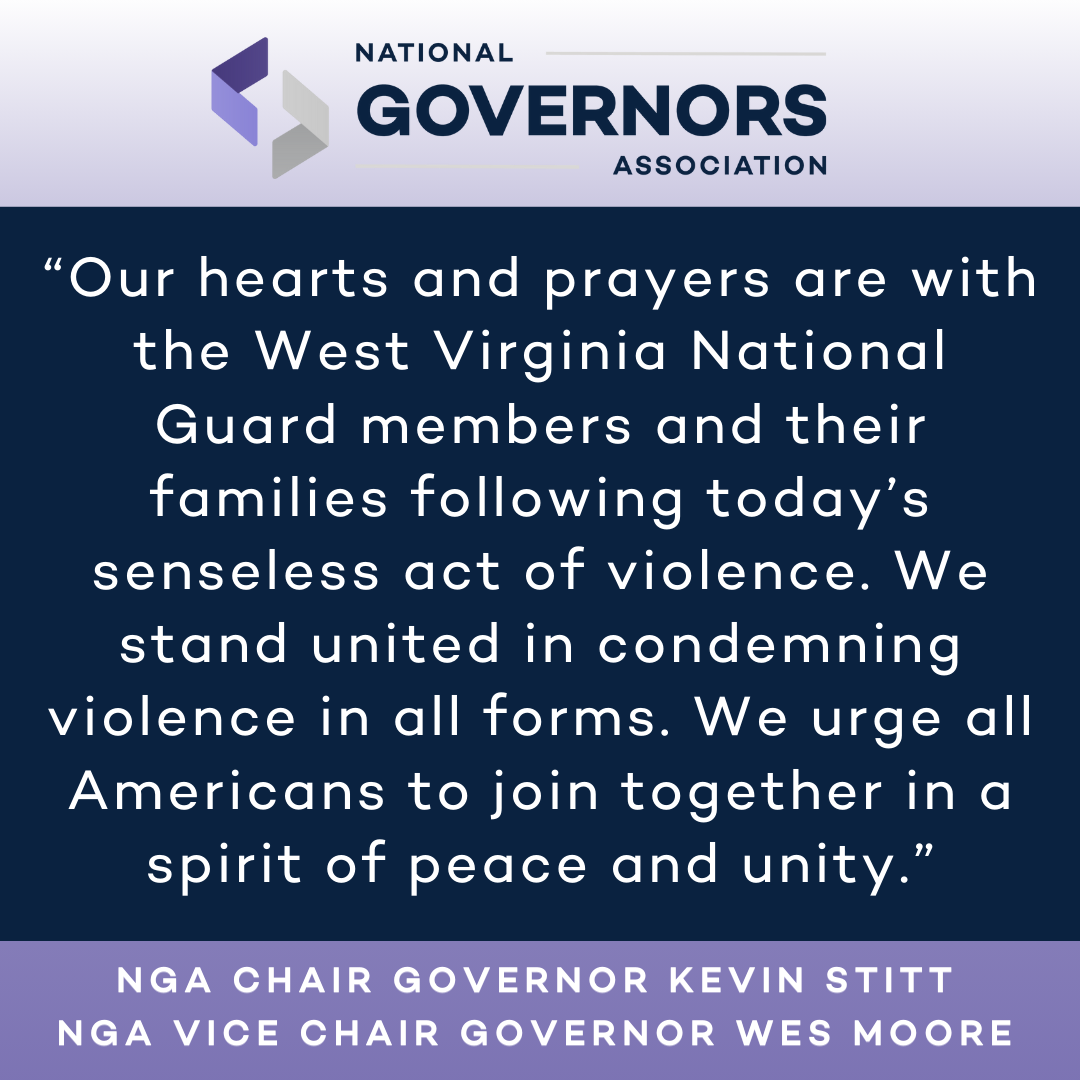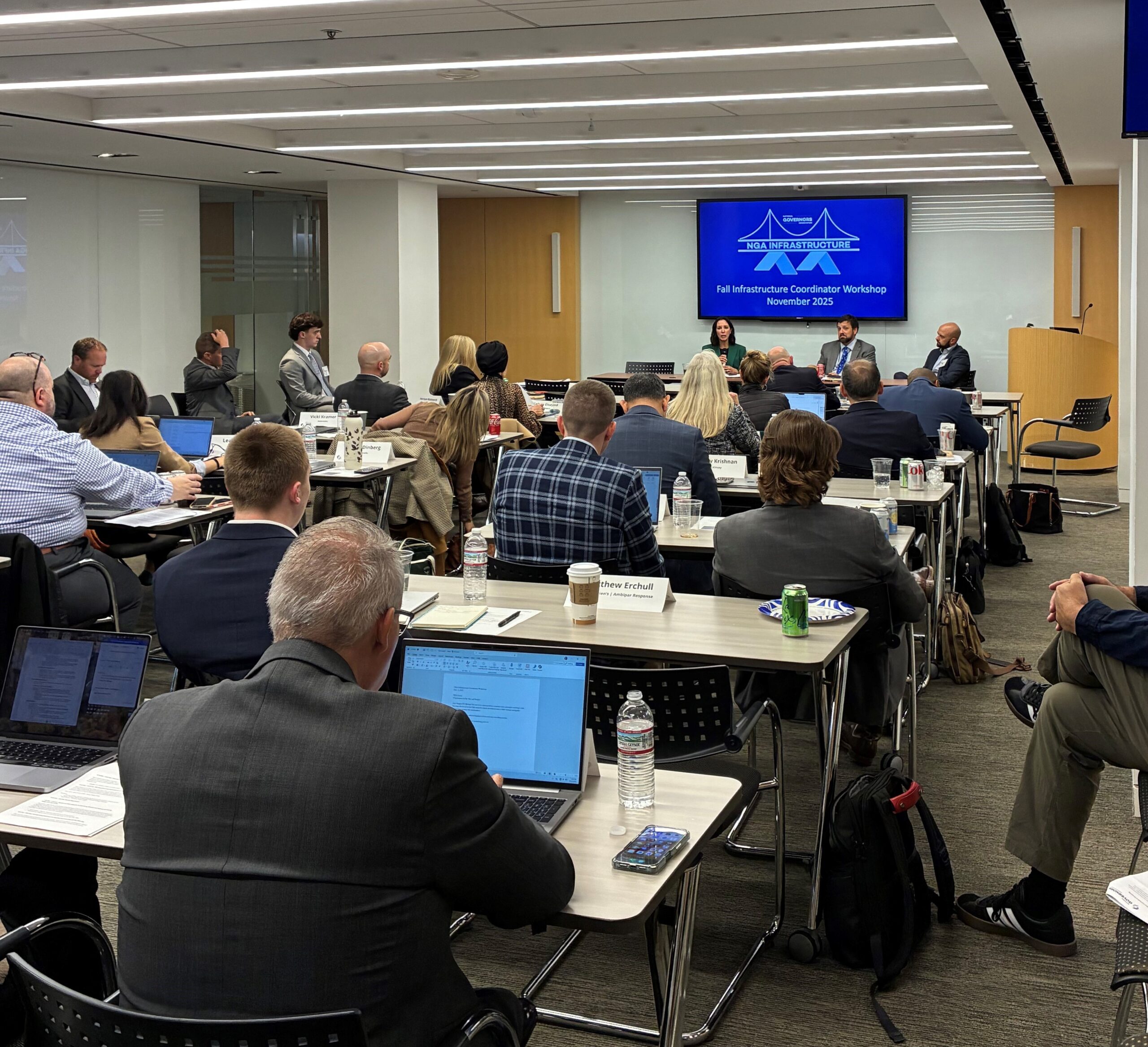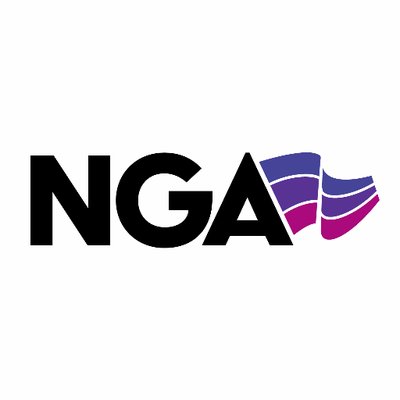Governors are committed to partnering with FEMA to modernize and strengthen our national disaster response system; however, meaningful reform must start with collaboration and transparency.
Submitted via email to: FEMAreviewcouncil@hq.dhs.gov
Subject: NGA Comments on FEMA Disaster Response Experiences; Docket No. DHS-2025-0013
Dear FEMA Review Council Members,
On behalf of the National Governors Association Public Health and Disaster Response Task Force, we are submitting comments regarding FEMA’s disaster response processes and recommendations to reform emergency response. These comments reflect recurring feedback and experiences expressed by the nation’s 55 Governors and their emergency management officials. They reflect common priorities for improving disaster response, while recognizing that implementation challenges and policy preferences may vary by state and region.
To further solidify disaster preparedness and response as a top priority, Governors included these areas within NGA’s Federal Priorities for 2025. Specifically, Governors are calling for:
- Enhance emergency response and disaster recovery by ensuring federal programs, such as Disaster Relief Fund, National Flood Insurance, and Community Development Block Grant Disaster Recovery, are sufficient, adaptable, and streamlined to meet the diverse needs of states and territories, and easier to navigate for individuals, businesses, and all levels of governments;
- Strengthen preparedness efforts by fostering both inter-state and federal-state collaborations to maintain resilient supply chains and stockpiles for critical infrastructure before, during, and after emergencies;
Overall Experience with FEMA
FEMA also becomes a critical partner when states and territories surpass their capacity to respond. In FY 2023 alone, 60 disasters received major federal declarations and assistance. However, states and territories managed 23,910 additional incidents independently. This illustrates the responsibility states and territories already have, and thus, the importance of a timely and responsive federal partnership when necessary.
Many states and territories, however, face significant obstacles in accessing federal disaster relief in a timely manner. Delays in funding, stringent application requirements, and a complex bureaucratic process often slow down recovery efforts. Additionally, rebuilding efforts can take years, requiring a more flexible and responsive federal partnership to begin with, to ensure communities are not left behind. The economic burden often extends beyond immediate recovery, straining state budgets and diverting resources from other critical services.
Observations from State and Territorial Leaders
These select bipartisan observations are representative of how disasters and response are similar and different across regions of our country.
Oklahoma:
“Delays in federal disaster declaration determinations remain a significant barrier to timely response and recovery efforts. While FEMA’s field operations are generally effective once activated, the initial lag in approving or denying state requests for assistance can create substantial operational challenges. In the absence of a clear federal response, states are forced to delay coordination, resource allocation, and public communication, which ultimately prolongs the recovery timeline and increases overall costs.
“Even after declarations are approved, administrative complexity within key FEMA programs contributes to inefficiency. Inconsistent staffing and procedural changes—particularly within the Public Assistance Program— often result in repeated documentation requests and conflicting guidance for applicants. These disruptions impose an additional burden on local governments and slow the delivery of critical support to affected communities.
“Disaster recovery is time-sensitive by nature, and the cumulative effect of bureaucratic delays is both financial and operational. A more streamlined, coordinated approach would enhance the effectiveness of federal aid and strengthen partnerships with states and localities.”
California:
Describe your experience with FEMA’s response to your request for assistance. Was FEMA’s response timely and efficient to assist in your recovery? FEMA Region 9 staff are critical partners and have supported our ability to quickly mobilize during disasters and navigate the complex federal recovery process. While we value this local partnership, there is ongoing frustration with the pace of federal review at the headquarters level. The process is further complicated by frequent changes in evaluation metrics, which creates uncertainty and delays in aid delivery.
Describe your overall experience with FEMA. Was your interaction with FEMA positive or negative? Please fully explain your experience. Our overall experience with FEMA is positive due to strong working relationships and support from FEMA staff. FEMA liaisons play an essential role by serving as a central point of contact, ensuring information flows between our state and FEMA, and coordinating resources and capabilities before, during, and after incidents. This partnership has significantly improved interagency coordination and response efforts.
We also value FEMA’s alert and warning systems which have proven effective during large-scale incidents like the Los Angeles firestorms. FEMA’s on-site technical support and training during that event helped strengthen local capacity and interagency collaboration. Other FEMA programs that provide financial support for temporary housing, repairs, medical needs, and personal property loss are vital to disaster support. Recent program reforms were well received. However, the method for determining needs, which often relies on broad state-level metrics, can overlook the severity of impacts in specific vulnerable communities. We recommend FEMA adopt a more localized approach to better address community-level need.
By what means did you apply for benefits—was it online, in person, or over the phone? Did you encounter any difficulties? Application methods vary depending on the incident. During the February fires, most survivors applied online, while more complex cases were handled in person at disaster recovery centers.
Were local or state authorities or private groups able to provide assistance in a more timely or efficient way than FEMA? Please fully describe your experience. While the FEMA Individual Assistance process has flaws, there are no equivalent state, local, or private programs that provide the same level of direct financial support to survivors. The recent removal of door-to-door canvassing is especially concerning, as it limits critical outreach to vulnerable populations. From a financial perspective, states and counties do not have the resources to replace FEMA’s direct aid.
Vermont:
In July of 2023 and 2024, Vermont experienced catastrophic flooding ranking among the most extensive and destructive natural disasters Vermont has had in the last 100 years. These events were more extensive in terms of damage and cost, and they persisted much longer compared to previous disasters.
As we experienced in 2011 with Tropical Storm Irene, the response from FEMA proved to be essential in supporting the state’s emergency management capability. During the 2023 and 2024 floods, as an example, FEMA was able to quickly move response capabilities on an appropriate scale to Vermont, such as providing a search and rescue contingent to assist and supplement the state and local teams.
FEMA’s most critical support comes as life-saving response shifts to recovery. In our experience, both state and local resources were maximized and overwhelmed. Emergency managers at every level were at times overpowered by the dynamic and extraordinary needs of the disaster. Most of our municipalities have small staff and rely on volunteer community members to fill crucial roles in response and recovery. In these cases, FEMA provided communities with necessary support and technical assistance derived from their experiences from a regular and nationwide rotation of disaster response. FEMA personnel were quick to provide help to impacted
Vermonters through local outreach and assistance in navigating the FEMA process and assessing household damage. Vermont would not have been able to do this on our own without federal support.
Having said that, while FEMA programs and resources are invaluable to Vermont, they are not flawless. As immediate needs shifted to long-term recovery, Vermont saw some limitations of FEMA’s capabilities. They were especially highlighted by FEMA field staff who were not empowered to make determinations and the FEMA central command structure second-guessing regional decisions. Frequent FEMA staff turnover also impaired the continuity of response and recovery efforts. Impediments, such as a very slow timetable in obtaining approvals and reimbursements, create unnecessary difficulties for small towns. For instance, many of our highly impacted towns exceeded their annual operating budgets just in the early response, making urgent repairs. This immediate outflow of cash combined with a slow reimbursement model is a challenge the state is not able to fill or finance alone. The extended timelines and lack of certainty in the 2023 and 2024 floods delayed recovery efforts and resulted in wasted resources due to partially funded projects. This was a far different experience than our initial experience with FEMA, when they provided a vital backstop of support to the state’s overwhelmed system. To sum it up in a single sentence; Vermont greatly appreciates the necessary support from FEMA, especially in response, but would like to see improvements in how recovery programs are managed.
Hawaiʻi:
Hawaiʻi has historically maintained a strong working relationship with FEMA Region 9 and the Pacific Area Office. From 2018 to 2025, the state experienced a variety of disasters—including hurricanes, wildfires, flooding, and volcanic activity—that triggered state emergency proclamations and federal disaster assistance. When these incidents exceeded local capacity, FEMA and federal partners provided essential support for both response and recovery.
The declaration process for certain types of Stafford Act assistance can be challenging due to documentation requirements and inconsistent approval standards. While the Public Assistance Program is generally more straightforward, it can become burdensome leading to delays in rebuilding. The Individual Assistance Program, in particular, lacks a standardized and transparent approval process.
Despite these challenges, Hawaiʻi’s experience with FEMA has been largely positive, grounded in strong collaboration between federal and state teams. During the August 2023 Maui Wildfires, FEMA played a critical role by deploying subject matter experts and offering technical assistance in areas such as environmental monitoring, debris removal, and disaster housing.
Survivors used a mix of online and in-person methods to apply for FEMA aid, with in-person services proving especially valuable in building trust and addressing immediate needs. While state, local, and private resources have supported recovery, they are limited in scale and speed. Timely federal deployment remains crucial to meeting the needs of affected communities.
State/Territory Mutual Aid in Disaster Response
An additional tool crucial to states during major disasters is the Emergency Management Assistance Compact (EMAC), which allows states and territories to share personnel and equipment across jurisdictions through a mutual aid agreement. As Governors have emphasized, FEMA plays a key role in integrating these efforts and supporting EMAC’s success through coordination and alignment with broader federal recovery operations can reinforce these state-to-state support mechanisms. Federal financial support for EMAC must be maintained to sustain and/or build upon this effective system.
Recommendations to the FEMA Review Council
Specific to the request of feedback on experiences with FEMA during disaster response, Governors recommend the following for the FEMA Review Council:
- Sufficiently fund and modernize core federal disaster programs to reflect the growing scale, frequency, and complexity of disasters. Programs must be sufficiently resourced to address compounding events like wildfires, floods, hurricanes, and more.
- Disaster survivors often struggle to access federal aid due to complex eligibility requirements and multiple application processes across more than 30 federal entities. A streamlined, universal application process and dedicated navigation support are critical to ensuring equitable disaster recovery.
- Strengthen coordination across federal agencies to avoid conflicting timelines, duplicative reporting requirements, and siloed funding streams that slow disaster recovery and frustrate stakeholders. Designating federal leads for long-term recovery within key agencies can enhance continuity, communication, and accountability.
- Allow greater flexibility in how recovery funds are used, including for mitigation, housing, transportation, or community infrastructure. Governors must be able to tailor solutions to their jurisdictions’ unique needs and resilience strategies rather than be constrained by rigid, one-size-fits-all programmatic rules.
- Support capacity-building for state and local governments, especially in rural or under-resourced areas, to help them manage recovery programs effectively. This includes technical assistance, surge staffing, and funding for administrative infrastructure.
- Quick and accurate damage assessments are crucial for disaster recovery. Utilizing state and local experts with critical knowledge of the area and history, along with federal expertise, can expedite assessments and improve resource allocation.
- States and localities need streamlined, predictable access to federal recovery resources. Reducing administrative complexity and approval timelines will support getting aid on the ground quicker and minimize disruption.
- Individuals, small businesses, and local governments navigating disaster assistance programs often face unnecessary confusion and red tape. Improving program transparency, eligibility clarity, and technical assistance will ensure that aid reaches those who need it most.
- Disaster survivors often struggle to access federal aid due to complex eligibility requirements and multiple application processes across more than 30 federal entities. A streamlined, universal application process and dedicated navigation support are critical to ensuring equitable disaster recovery.
Conclusion
Governors are committed to partnering with FEMA to modernize and strengthen our national disaster response system; however, meaningful reform must start with collaboration and transparency. NGA encourages the Review Council to consider these perspectives not as isolated encounters, but as ideas of where strategic investment and coordination can lead to stronger outcomes for all Americans.
We appreciate the opportunity to contribute to this critical conversation and stand ready to support further discussion.
Sincerely,
Governor Josh Green
State of Hawaii
Co-Chair, Public Health and Disaster Response Task Force
Governor Phil Scott
State of Vermont
Co-Chair, Public Health and Disaster Response Task Force


